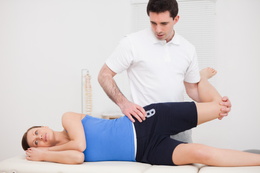The symptoms of a pulled groin muscle are very annoying and often affect normal movements. This article provides some information about the symptoms and the possible ways to get relief from the same.

Groin muscles belong to the abductor muscle group. It consists of six muscles that are located in between the inner pelvis and inner part of the femur or thigh bone. These muscles work in coordination with each other to perform activities like walking, running, and other kinds of movements. Pulled groin muscle is an injury which is sustained mainly due to overuse, traumatic injury, sports injury, etc. The intensity of the symptoms varies from mild to severe depending on how badly the muscle fibers are stretched.
Symptoms
This condition is often categorized into three different grades; grade I, II, and III. A grade I muscle pull is just a minor pull and a grade II pull is moderate in nature. However, a grade III muscle pull is a serious form of injury that may cause a rupture in the muscle fibers. The symptoms of these three grades of injury are given below.
Grade I
This kind of muscle pull causes a little bit of discomfort in the inner thigh area only during vigorous movements such as jumping, running, etc. While doing these activities, stiffness can be felt in these muscles. A tenderness is there when one touches the site of injury. However, one can walk without any difficulty.
Grade II
This will give rise to a sudden sharp pain as soon as the muscle gets pulled. This usually occurs while doing some exercise or sport activities. The tightness of the muscle would worsen with the passage of time. Movements like stretching of the muscles and running is going to be extremely painful. A mild pain can be felt during walking as well. This pain is often accompanied by bruising and swelling because of breaking of blood vessels. It can even lead to weakening of the muscle.
Grade III
In this case, acute groin pain is experienced suddenly while doing some activity. It starts soon after the injury and continues to bother the affected person all the time. The pain makes squeezing of the legs a painful affair. Within 24 hours of injury, significant swelling and bruising can be noticed in the inner thigh area. On touching the painful site, a knot or lump in the muscle can be felt. The symptoms may get so severe that one's sleep may get disrupted.
Treatment
The first thing that needs to be done to fix such problems is to provide adequate amount of rest to the muscles. Suspend all activities in order to relax the muscles. It would be better if the leg is kept at an elevated position for the first 24 hours. Application of ice will have a soothing effect on the pulled groin muscle. Infection chances are also minimized when this is done. Wrap a few cubes of ice in a piece of cloth and apply it over the injury for 10-15 minutes and not more than that. It should be repeated a number of times throughout the day. If the muscle pain is unbearable, over-the-counter pain relieving medicines can be taken for pain management but only after consulting the doctor. Wrapping the upper thigh area with an elastic compression bandage is going to prevent any further swelling. Once the swelling is gone, heat application helps to heal the injury faster. Heat should be applied for half an hour twice a day. As the pain subsides, do some mild stretching exercises which will help to speed up the recovery process. Physical therapy can be highly beneficial for strengthening of the injured muscles. If the symptoms refuse to improve after the first few days of treatment, then consult the doctor for further treatment. If the muscle is in a badly damaged state, doctors may recommend a surgery.
This kind of groin injury takes a lot of time to heal. Therefore, one needs to have patience and should not rush to resume any strenuous activity. This could lead to a relapse of the pulled groin muscle symptoms. After pulled groin recovery, keep the body fit by eating healthy foods and following an exercise regime regularly to prevent any such injuries in the future.
Disclaimer:
This Buzzle article is for informative purposes only, and should not be used as a replacement for expert medical advice.


 Groin muscles belong to the abductor muscle group. It consists of six muscles that are located in between the inner pelvis and inner part of the femur or thigh bone. These muscles work in coordination with each other to perform activities like walking, running, and other kinds of movements. Pulled groin muscle is an injury which is sustained mainly due to overuse, traumatic injury, sports injury, etc. The intensity of the symptoms varies from mild to severe depending on how badly the muscle fibers are stretched.
Groin muscles belong to the abductor muscle group. It consists of six muscles that are located in between the inner pelvis and inner part of the femur or thigh bone. These muscles work in coordination with each other to perform activities like walking, running, and other kinds of movements. Pulled groin muscle is an injury which is sustained mainly due to overuse, traumatic injury, sports injury, etc. The intensity of the symptoms varies from mild to severe depending on how badly the muscle fibers are stretched.